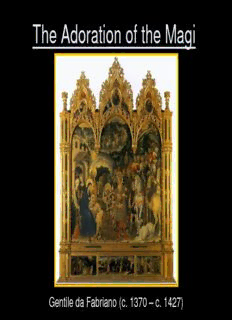
The Adoration of the Magi PDF
Preview The Adoration of the Magi
The Adoration of the Magi Gentile da Fabriano (c. 1370 – c. 1427) The Adoration of the Magi This talk is based on two (2) articles / reflections in the The Sower magazine (October – December 2007) by Lionel Gracey and and Caroline Farey. The Adoration of the Magi Gentile da Fabriano (c. 1370 – c. 1427) was an Italian painter known for his participation in the International Gothic style. Gentile was born in or near Fabriano, in the Marche. His mother died some time before 1380 and his father, Niccolò di Giovanni Massi, retired to a monastery in the same year, where he died in 1385. He worked in various places in central Italy, mostly in Tuscany. His best known works are his Adoration of the Magi (1423) and Flight into Egypt. The Adoration of the Magi About 1422 he went to Florence, where in 1423 he painted an "Adoration of the Magi" as an altarpiece for the church of Santa Trinita, which is now preserved in the Uffizi Gallery in Florence. This painting is considered his best work now extant and regarded as one of the masterpieces of the International Gothic style. He had by this time attained a wide reputation, and was engaged to paint pictures for various churches, more particularly Siena, Perugia, Gubbio and Fabriano. The Adoration of the Magi About 1426 he was called to Rome by Pope Martin V to adorn the church of St. John Lateran with frescoes from the life of John the Baptist. He also executed a portrait of the pope attended by ten cardinals, and in the church of St. Francesco Romano a painting of the "Virgin and Child attended by St. Benedict and St. Joseph", which was much esteemed by Michelangelo, but is no longer in existence. The Adoration of the Magi Michelangelo Gentile da Fabriano died about 1450. Michelangelo said of him that his works resembled his name, meaning noble or refined. They are full of a quiet and serene joyousness, and he has a naïve and innocent delight in splendour and in gold ornaments, with which, however, his pictures are not overloaded. The Adoration of the Magi The source of this painting is Matthew’s Gospel (Mt 2:1-12). By the time this altarpiece was painted the wise men were being depicted as kings. This may be because Matthew’s story came to be linked with Psalm 72. It may also be because of the costly gifts they brought with them. The Adoration of the Magi The Magi were a tribe from ancient Media. The Medes were an ancient Iranian people who lived in the north-western part of present-day Iran. The best known Magi are the "Wise Men from the East" mentioned by Matthew in his Gospel, whose graves Marco Polo claimed to have seen in what is today the district of Saveh, in Tehran, Iran. In English, the term may refer to a shaman, sorcerer, or wizard; it is the origin of the words magic and magician. The Adoration of the Magi In his The Histories Herodotus lists the names of six Mede tribes: • Busae • Paretaceni • Struchates • Arizanti • Budii • Magi The Adoration of the Magi The Wise Men are given the names Caspar, Melchior, and Balthasar in this late 6th century Romanesque mosaic from the Basilica of St Apollinarius in Ravenna, Italy. In fact, their number is unknown as it is not stated in Matthew’s Gospel; only that there were three gifts — the supposition that this implied only three givers is speculation.
Description: